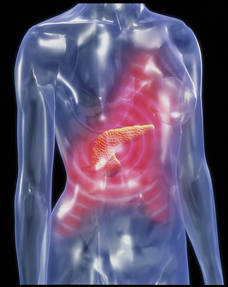Long-term view for chronic pancreatitis
Unlike acute cases of pancreatitis, chronic cases present with varying degrees and types of pain, and without other clinical indicators such as calcification or damage to pancreatic ducts. It's best to refer to a gastroenterologist early to clarify the diagnosis, so the internist can better manage the patient.
Chronic pancreatitis accounts for more than 122,000 outpatient visits and more than 56,000 hospitalizations every year in the U.S., according to guidance published by the Cleveland Clinic. But unlike acute pancreatitis, chronic pancreatitis is not so easily diagnosed.
Whereas diagnosing acute pancreatitis is largely a matter of testing serum amylase and lipase, these pancreatic enzymes may not be elevated in patients with chronic pancreatitis. Likewise, the pain profile for chronic pancreatitis can be highly variable.

Acute pancreatitis causes severe, unrelenting pain that often sends patients to the emergency department. In chronic pancreatitis, pain may be dull, continual or episodic with relation to eating, and it may change or even disappear over time. Pain can occur early in the course of the disease, before structural abnormalities in the pancreas become apparent via imaging.
“There often isn't any sign of calcification on imaging, and the pancreatic ducts may not be damaged,” said Scott M. Tenner, MD, MPH, FACP, director of medical education and research in the division of gastroenterology at Maimonides Medical Center in Brooklyn and associate professor at the State University of New York. “Internists will often scratch their heads and wonder if there are any better clues to diagnosis.”
Because the other symptoms of chronic pancreatitis, such as pain, early satiety, nausea, diarrhea, oily stools, weight loss, jaundice, and malabsorption of nutrients, vitamins and fats, overlap with several gastrointestinal conditions, it's best to refer patients to a gastroenterologist early in the process, said Michael L. Kochman, MD, FACP, Wilmott Family Professor of Medicine and vice chair of medicine for clinical services at the University of Pennsylvania in Philadelphia.
“The role for the gastroenterologist is to ensure the correct diagnosis and make sure there is not another cause for the symptoms and to help determine the etiology of the pancreatitis,” Dr. Kochman said. He noted that gastroenterologists are often the ones to perform or consult on the tests and procedures associated with diagnosis, such as magnetic resonance imaging, magnetic resonance cholangiopancreatography, endoscopic ultrasonography and endoscopic retrograde cholangiopancreatography.
“Once the diagnosis is clear, most internists should be able to handle many patients with the condition,” Dr. Kochman said.
Causes
The Cleveland Clinic, through its Center for Continuing Education's Disease Management Project, published guidance on chronic pancreatitis for practicing physicians, which states that chronic alcohol abuse is the leading culprit behind chronic pancreatitis. It causes more severe pain, more damage to the pancreas and ducts, and a quicker progression to loss of endocrine and exocrine function. A review of the literature on the management of chronic pancreatitis published in the May 2013 Gastroenterology defines very heavy drinking as long-term ingestion of 5 or more drinks per day.
However, a predisposition to chronic pancreatitis from alcohol abuse is in part genetically determined, said Jonathan S. Appelbaum, MD, FACP, director of internal medicine education at Florida State University College of Medicine in Tallahassee.
“I've seen patients who drank considerable amounts of alcohol and never developed problems, while others who drank less developed chronic or acute pancreatitis,” Dr. Appelbaum said. “It's like cigarette smoking, where some will get lung cancer and others won't. The main risk comes from repeated bouts that insult the pancreas over time.”
An example of this was recently demonstrated in a genome-wide association study published in December 2012 in Nature Genetics where patients with alcoholic chronic pancreatitis were more likely to have mutation in the Claudin-2 gene.
The TIGAR-O Classification, first published in the February 2001 Gastroenterology, separates pancreatitis into 6 categories: toxic-metabolic (to include alcohol), idiopathic, genetic, autoimmune, recurrent and severe acute, and obstructive. Internists are largely tasked with treating the pain of chronic forms of pancreatitis, overseeing nutrition and drug therapy, monitoring patients for changes in symptoms and pancreatic sufficiency, and ordering routine tests to determine the progress of the disease.
Chronic pancreatitis can result from taking medications, but Dr. Tenner pointed out that drug-induced pancreatitis is a complicated subject. “Literally hundreds of drugs have been implicated in the literature, but in fact probably very few actually cause chronic pancreatitis. The studies are very poor,” he said.
Several studies indicate that roughly one-third of cases are idiopathic. In the past 15 years, mutations in several genes that increase the risk of pancreatitis have been identified, such as PRSS1, SPINK1 and CFTR.
“Idiopathic cases may be on par with diverticulitis and appendicitis, where you ask a clinician what caused it and they say they don't know. It may just be a situation where the pancreas becomes inflamed,” said Dr. Tenner.
Patients who have had prior, recurrent acute pancreatitis are at increased risk for chronic pancreatitis.
“Depending on the severity of the attacks of acute pancreatitis, there can be damage to the small or main ducts in the pancreas that lead to scarring and other changes [that lead to chronic pancreatitis],” said Dr. Kochman.
Dr. Tenner noted that patients with established type 2 diabetes have increased risk for chronic pancreatitis. “These patients tend to have more gallstones than the general population. They also tend to have high triglycerides as part of the metabolic syndrome, which can raise the risk of developing chronic or acute pancreatitis,” he said.
Pain management
In many cases, lifestyle changes that slow the progression of chronic pancreatitis will also alleviate pain, said Frank G. Gress, MD, FACP, clinical chief of the division of digestive diseases at New York-Presbyterian Hospital/Columbia University Medical Center in New York.
“Although chronic pancreatitis is not reversible, patients can help prevent progression by avoiding behavior that can worsen it, notably alcohol consumption and smoking,” Dr. Gress said, noting that smoking is an independent risk factor for chronic pancreatitis.
Dhiraj Yadav, MD, MPH, associate professor in the division of gastroenterology, hepatology and nutrition at the University of Pittsburgh School of Medicine, agreed.
“Counseling patients on alcohol consumption is imperative. There is a common, and false, presumption that patients will not stop drinking, but there is empiric data that counseling these patients regarding abstinence can be effective,” Dr. Yadav said. A study appearing in the April 11, 2009, Gastroenterology suggested that simple interventions such as a 30-minute discussion can help patients abstain from alcohol when delivered in a repeated and systematic way.
Dr. Yadav also stressed the importance of discussing smoking. “Even when physicians counsel to abstain from alcohol, they may or may not counsel on smoking. Smoking cessation should be encouraged as well,” he said.
Dietary adjustments can help alleviate pain, said Dr. Gress. “Patients should maintain a fat-free or low-fat diet. High-fat diets stimulate the pancreas the most. As the pancreas fails, it can't release enzymes, and there is more swelling and more fibrosis and scarring, resulting in more pain,” he said.
The next step is medication. The Cleveland Clinic notes that non-narcotic analgesics such as NSAIDs, acetaminophen and tramadol can be effective, but if pain persists, low doses of mild narcotics such as codeine or propoxyphene may be added.
Several studies indicate that approximately half of all patients with chronic pancreatitis will be treated with opioids, but the May 2013 review in Gastroenterology cautions that patients with previous addictive behaviors, including alcoholism and smoking, have increased risk for becoming addicted to these drugs.
“Unfortunately with narcotics, there can be problems with dependency,” said Dr. Tenner. “Remember that while narcotics are great for acute pain, they really should only be used for short duration.”
Supplementation with pancreatic enzymes may also help with pain, said Dr. Gress. “They allow the pancreas to take a break, but they also improve the quality of life for patients who have malabsorption [and associated diarrhea],” he noted.
Dr. Yadav pointed out that in a patient with chronic pancreatitis and pain, cross-sectional imaging studies such as a contrast-enhanced CT scan are very helpful to determine whether the patient can be a candidate for endoscopic therapy or surgical treatment. Endoscopic treatment with or without lithotripsy can be helpful to remove stones from the pancreatic duct, place stents and treat complications such as bile duct strictures or pseudocysts. In selected patients, surgery may be helpful. Total pancreatectomy with islet autotransplantation (TPIAT) can be an option for patients with severe pain not responding to conventional treatment.
Nutrition
Measures to prevent vitamin and mineral deficiencies are part and parcel of treating patients with chronic pancreatitis, said Dr. Kochman. “A mainstay of treating this disease is to make sure patients are not malabsorbing fat-soluble vitamins and to replenish those vitamins if they are,” he noted.
Patients with chronic pancreatitis are at increased risk for conditions related to deficiencies in vitamins A, D and E, particularly bone loss due to vitamin D malabsorption. A monograph published in the February 2010 Gastroenterology & Hepatology recommends regular testing of levels of 25-hydroxyvitamin D, as well as bone scans to prevent the development of metabolic bone disease.
Dr. Appelbaum noted that pancreatic enzyme supplementation can help with malabsorption, and its effectiveness is easily assessed.
“Regular testing can tell you how your patients are doing. Generally stable patients may need to come in every 3 months,” said Dr. Appelbaum. “But it's also by symptom. You dose the enzymes so the diarrhea stops. Once that stops, you know the enzymes are working. Patients really can't take too much of those.”
The Cleveland Clinic suggests a minimum of 30,000 U of lipase per meal to allow for adequate digestion of fat and protein, although the dose may need to be increased to as much as 60,000 to 80,000 U per meal because not all of it will reach the small intestine in active form. In addition, the guidance stated, the enzymes in uncoated tablets are susceptible to gastric acid, and one way of addressing this is to add a proton-pump inhibitor or histamine-receptor antagonist. Enteric-coated tablets are another option.
Complications and cancer
Although complications of chronic pancreatitis such as pseudocysts, biliary and gastric outlet obstructions, and pancreatic duct disruption are typically treated surgically, the experts agree that internists should be on the lookout for worsening symptoms of chronic pancreatitis that may suggest these complications, such as increased or unresponsive pain or changes in the type of pain experienced.
Internists should also be aware of the increased risk of pancreatic cancer in patients with chronic pancreatitis, said Dr. Gress.
“The risk of pancreatic cancer in these patients is usually about 5- to 10-fold that of people without chronic pancreatitis, especially in patients who have had chronic pancreatitis for more than 10 years,” Dr. Gress said. “Things to look for are worsening pain, significant weight loss, and symptoms of obstructive jaundice.”
Patients with chronic pancreatitis are also at increased risk for diabetes due to destruction of islet cells in the pancreas, said Dr. Yadav. “Diabetes is one of the cardinal symptoms of chronic pancreatitis. Diabetes is seen in 20% to 60% patients with chronic pancreatitis.”
Dr. Yadav added that diabetes is independently associated with acute pancreatitis—”The risk is 1.5- to 3-fold after controlling for other risk factors”—so internists should keep that in mind when patients come for follow-up care after an acute attack.
Diabetes can also be a sign of pancreatic cancer, said Dr. Yadav. “If it's new-onset diabetes, there are abdominal symptoms, and the patient does not have a history of pancreatic disease, have a high degree of suspicion, especially if the symptoms include pain, weight loss, and diarrhea,” he said. “That's when you refer for imaging.”
Patients with cystic fibrosis and patients with familial chronic pancreatitis require special consideration, said Dr. Gress, noting that in these populations, chronic pancreatitis is largely a manifestation of genetic mutation. Chronic pancreatitis tends to strike these patients earlier in life and be more severe.
“When patients with cystic fibrosis develop chronic pancreatitis, it works the same way as cystic fibrosis works in the lung, with excess mucus production,” Dr. Gress said. “The mucus production causes stones in the pancreatic duct that causes obstruction, which then damages the pancreas.” Cystic fibrosis treatments can also help with chronic pancreatitis, Dr. Gress added.
Patients with familial chronic pancreatitis can be difficult to treat. “They usually require surgery normally reserved as a last resort, where the pancreas is filleted down the middle and part of it is sewn to the wall of the small bowel to allow for adequate drainage,” Dr. Gress said.
Regardless of cause, complexity or patient population, internists treating chronic pancreatitis should work in tandem with specialists throughout the disease course, said Dr. Tenner.
“Providing the best treatment requires good communication between the internist and the gastroenterologist,” he said. “It's a progressive and irreversible disease, and many patients do eventually need surgery.”.




